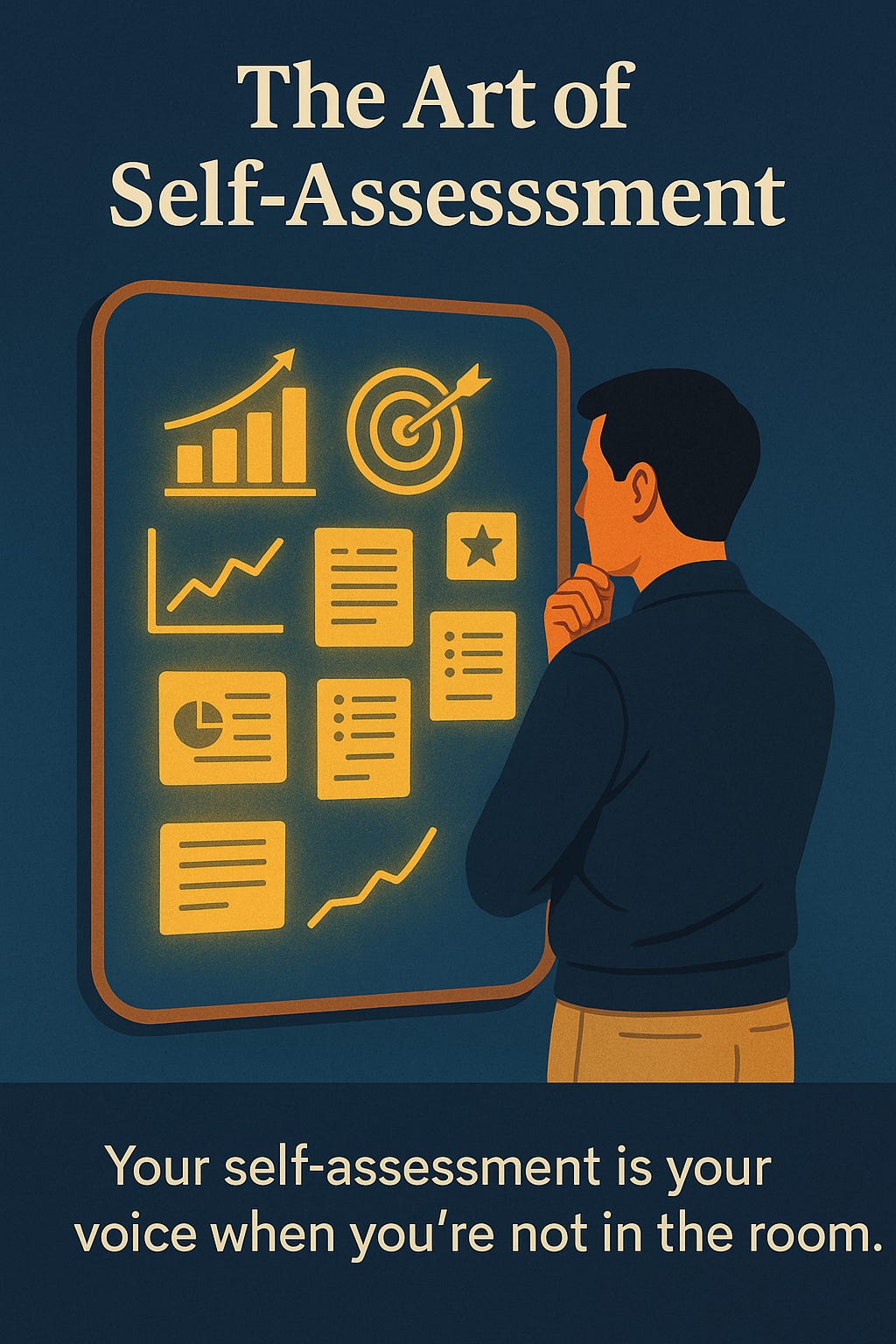The Art of the Self-Assessment: How to Write a Stellar Self Review That Speaks for Itself
Your work deserves to shine. Here’s how to make sure your manager and their manager see your impact clearly and unambiguously during performance reviews.
Introduction: Great Work Deserves Great Storytelling
So you’ve done great work this year. You’ve shipped projects, solved problems, helped your team win. And now, it’s time for that crucial step that many overlook: writing your self-assessment.
Here’s the thing, writing a strong self-assessment is a skill. I struggled for years. Early on, I believed hard work alone would get me recognized. But I learned the hard way that without effectively communicating your impact, even the best work can go unnoticed.
Over time, I studied, practiced, and refined my approach. I listened to feedback, observed what worked (and what didn’t), and developed a framework (I might change it next year as I learn) that has helped me consistently earn top ratings not just by delivering great results, but by presenting them clearly, concisely, and in alignment with what the company values.
These are general guiding principles that can be adopted by both individual contributors and managers. I used them when I was an IC, and I continue to apply similar principles in my manager journey today.
This post is my attempt to share those lessons with you. I hope it helps you unlock your next level and gives your manager all the ammunition they need to advocate for you with confidence.

How to Write Self-Assessment: A Step-by-Step Framework
1️⃣ Bulletproof Your Results: Clear, Quantifiable Impact
Write in bullets - avoid paragraphs as much as possible.
State what you did and the measurable impact (e.g., “Reduced cloud costs by 30%, saving $1.2M annually”).
Help your manager justify your rating their reputation is on the line in calibration meetings. Make it easy for them to advocate for you.
🗝️ Pro Tip: Think of your self-assessment as a “manager’s cheat sheet” for the review discussion.
2️⃣ Align to Team Goals: The North Star of Relevance
Map your contributions directly to your team’s OKRs or strategic priorities.
This alignment shows you’re not just an individual contributor, but a team player moving the mission forward.
Makes it easy for your manager to lift your points into team narratives.
3️⃣ Reflect the Leadership’s Voice: Learn from What They Celebrate
Listen to what your senior leaders praise in All-Hands, town halls, and emails. These are your signals.
If your company celebrates bold innovation, highlight how you took risks.
If they value stability, emphasize reliability and risk mitigation.
Quote public forums to anchor your contributions in company-wide wins.
4️⃣ Amplify Others: Be the Rising Tide
Show how you helped others win, mentored peers, supported cross-functional teams or enabled success.
Collect feedback early, not just during review season.
Remind peers of shared wins to counteract recency bias.
Quantify cross-functional impact: “Partnered with X team, enabling delivery of Y feature, resulting in Z% increase in adoption.”
5️⃣ Go Beyond Your Job: Elevate Your Scope
Did you take on new initiatives? Mentor others? Contribute to hiring, onboarding, or culture?
These above-and-beyond actions differentiate top performers.
Remember: Stars don’t just shine in their lane they light up the whole room.
6️⃣ Study the Role Guide: Know the Bar, Beat the Bar
If your company has a level guide, read it like your career depends on it because it does.
Align your self-assessment to show you’re performing at or beyond the expectations for your level and one level up.
Build a promotion-ready narrative if you think you are ready. ( I bet you think you are ready. I think I’m ready too :) )
7️⃣ Honesty, Always
Don’t oversell. Don’t underplay.
Acknowledge challenges and how you addressed them.
Authenticity builds trust and credibility.
8️⃣ Make It Easy: Clear, Concise, Copy-Paste Ready
Your self-assessment should avoid being like a laundry list of random items all over the place. It’s a concise summary of your impact:
✅ Clear
✅ Concise
✅ Fact-based
✅ Manager-ready
Reflection Prompts: Sharpen Your Narrative
What were your top 3 measurable contributions this year?
How did you help others succeed?
Where did you take risks, and what did you learn?
What feedback did you receive, and how did you act on it?
What did you do that aligns with your company’s top priorities?
Real-World Example Quotes
“I realized that if I don’t tell my story, no one else will.” – Anonymous Senior Engineer at a Fortune 50 Company
“Your self-assessment is the bridge between your work and your manager’s narrative. Build it strong.” – Ethan Evans, former VP at Amazon
“The self-review is not just a reflection, it’s your elevator pitch when you’re not in the room.” – Engineering Manager, Google
Citing the Research: Why This Matters
📊 Harvard Business Review: Only 29% of employees feel confident in how they present their performance.
📊 Gartner: Employees who clearly articulate their impact are 40% more likely to receive strong advocacy from their managers during calibration.
📊 McKinsey & Company: Companies with strong self-assessment cultures see 50% higher promotion rates among top performers.
Conclusion: Own Your Story
Your self-assessment is your voice when you’re not in the room. It’s your chance to advocate for your work, your growth, and your future.
This is how I write my self-assessments by aligning to goals, quantifying impact, helping others win, and making it easy for my manager to advocate for me.
I’m still learning. I’d love to hear how do you write your self-assessment? Share your thoughts in the comments, and let’s learn together.



